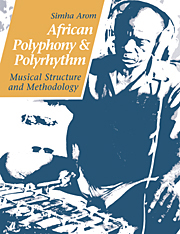Book contents
- Frontmatter
- Contents
- List of illustrations
- Foreword by György Ligeti
- Preface
- Acknowledgements
- BOOK I THE MUSIC OF THE CENTRAL AFRICAN REPUBLIC
- BOOK II AFRICAN POLYPHONIC MUSIC
- BOOK III TECHNICAL TOOLS: METHODS OF RECORDING POLYPHONIC MUSIC FOR TRANSCRIPTION
- BOOK IV THEORETICAL TOOLS
- BOOK V THE ORGANISATION OF TIME IN AFRICAN MUSIC
- BOOK VI STRUCTURAL PRINCIPLES AND THEIR APPLICATION
- Conclusion
- Bibliography
Foreword by György Ligeti
Published online by Cambridge University Press: 27 January 2010
- Frontmatter
- Contents
- List of illustrations
- Foreword by György Ligeti
- Preface
- Acknowledgements
- BOOK I THE MUSIC OF THE CENTRAL AFRICAN REPUBLIC
- BOOK II AFRICAN POLYPHONIC MUSIC
- BOOK III TECHNICAL TOOLS: METHODS OF RECORDING POLYPHONIC MUSIC FOR TRANSCRIPTION
- BOOK IV THEORETICAL TOOLS
- BOOK V THE ORGANISATION OF TIME IN AFRICAN MUSIC
- BOOK VI STRUCTURAL PRINCIPLES AND THEIR APPLICATION
- Conclusion
- Bibliography
Summary
In autumn 1982 a former student of mine, the Puerto Rican composer Roberto Sierra, brought to my attention a collection of instrumental and vocal ensemble music of the Banda-Linda tribe from the Central African Republic, recorded by Simha Arom. The record ‘Banda Polyphonies’, then several years old, was no longer available so I re-recorded it on to a cassette and made a photocopy of Arom's introductory text. Having never before heard anything quite like it, I listened to it repeatedly and was then, as I still am, deeply impressed by this marvellous polyphonic, polyrhythmic music with its astonishing complexity.
For many years I have been fascinated by the musical epoch from Vitry and Machault to Ciconia, and since my acquaintance with his work in 1980, by the music of Conlon Nancarrow. Undoubtedly my interest in the music Arom has recorded stems also from the proximity I feel exists between it and my own way of thinking with regards to composition: that is, the creation of structures which are both remarkably simple and highly complex. The formal simplicity of sub-Saharan African music with its unchanging repetition of periods of equal length, like the uniform pearls of a necklace, is in sharp contrast to the inner structure of these periods which, because of simultaneous superpositioning of different rhythmic patterns, possesses an extraordinary degree of complexity. Gradually, through repeated listening, I became aware of this music's paradoxical nature: the patterns performed by the individual musicians are quite different from those which result from their combination.
- Type
- Chapter
- Information
- African Polyphony and PolyrhythmMusical Structure and Methodology, pp. xvii - xviiiPublisher: Cambridge University PressPrint publication year: 1991



